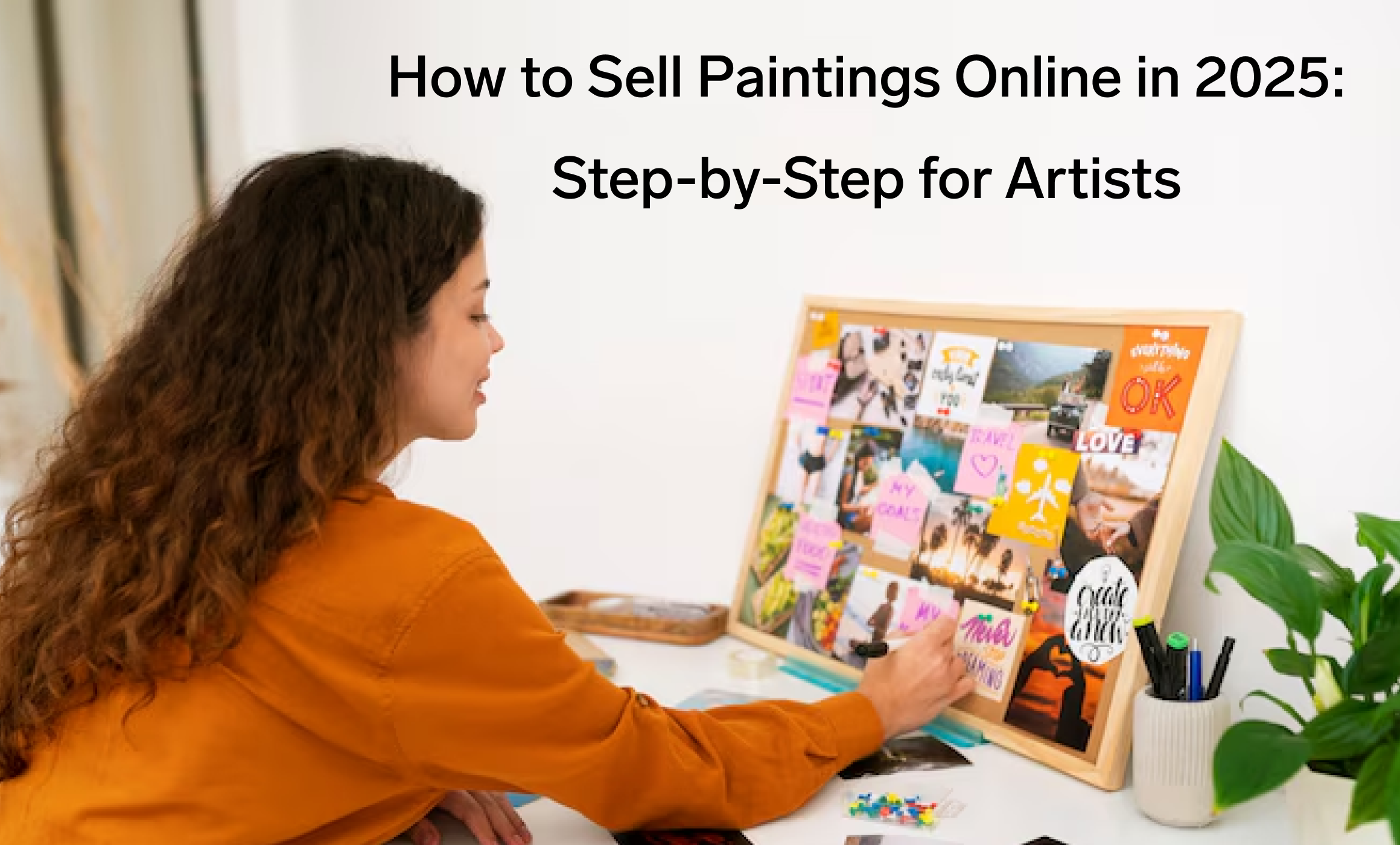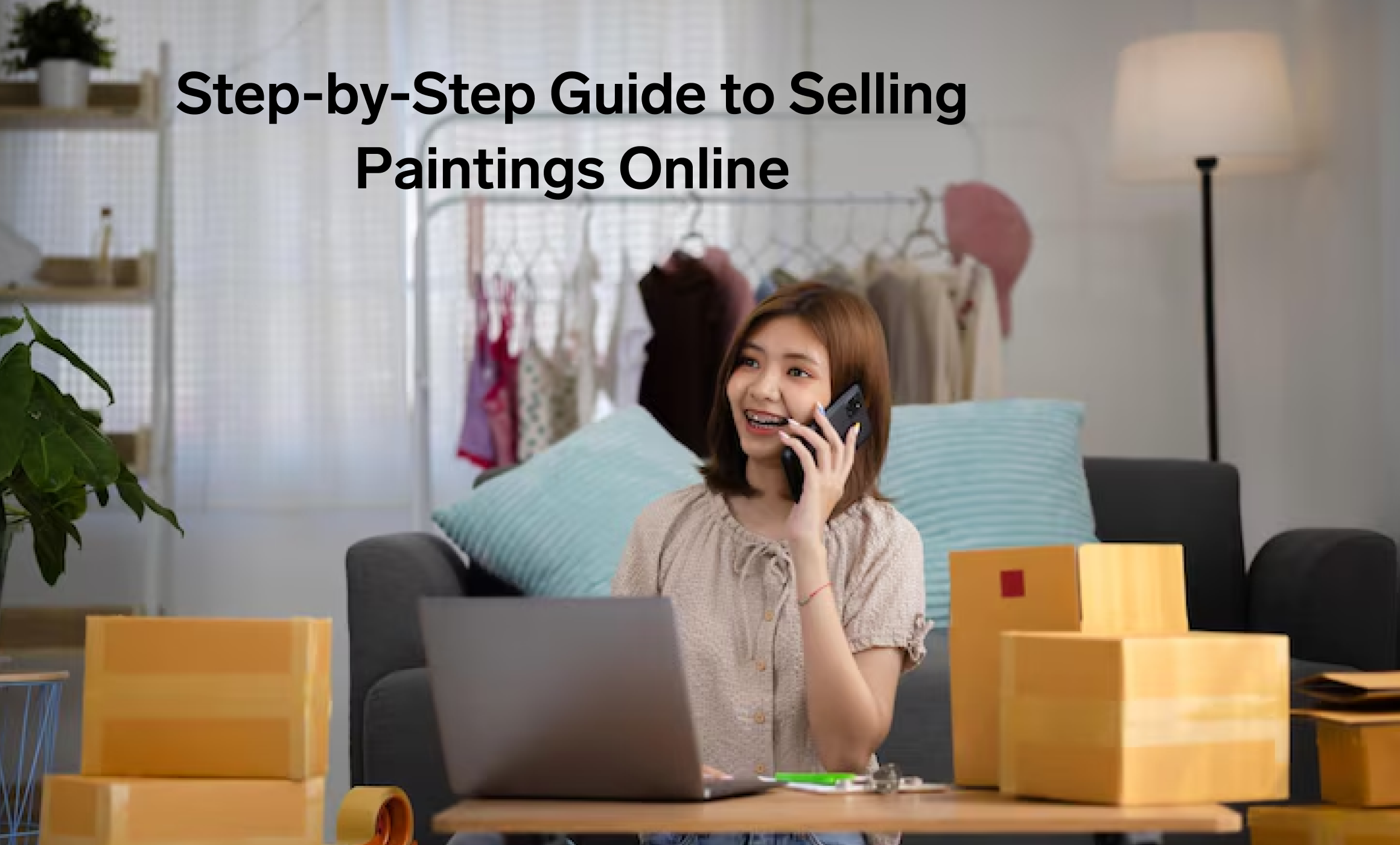How to Sell Paintings Online in 2025: Step-by-Step for Artists
Table of Contents
Digital art has transformed the way artists and art collectors connect, allowing for global interaction like never before. With the rise of online platforms and digital galleries, artists now have the ability to reach audiences far beyond their local communities. This digital shift has opened up endless possibilities for exposure, collaboration, and growth within the art world.
Whether you’re an experienced painter or just starting out, selling art online presents exciting opportunities to turn your passion into profit. Platforms like Etsy, Instagram, and personal websites give artists powerful tools to display their work, connect with potential buyers, and build a brand. The flexibility of online sales means that artists can manage their business from anywhere, reaching collectors across the world without needing a physical gallery.
This guide will walk you through proven strategies for selling your artwork online and managing a successful art business. From setting up an attractive online store and pricing your art competitively to promoting your work through social media and engaging with your audience, each step is key to growing your presence. By embracing the digital space, today’s artists can create sustainable careers and thrive in a connected, creative economy.

Why Sell Paintings Online?
The growth of the online art market has been amazing, as platforms bring in billions of dollars yearly. Online selling puts you in charge of your prices, how you display your work, and your communication with buyers. You can connect with customers from around the world at any time, try out different pricing, and expand your brand globally.
Nowadays, many skilled artists depend on selling their paintings, prints, or digital work through the internet as their main income. The most important thing is to select a strategy that fits your artistic career and your business needs.
It’s important to be clear about how you plan to sell your paintings prior to setting up your website. Every approach brings something different to the table:

Building your own art website gives you the highest level of control and financial gain. All of the profits from your sales are yours (less the fees charged by payment processors), you build your brand and keep your customer data for future advertising.
| Pros | Cons |
|---|---|
|
|
Etsy, Saatchi Art, and Fine Art America make it easier for artists because they already have ready customers who trust the platform.
| Pros | Cons |
|---|---|
|
|
Demo your art by posting it on Instagram, Facebook, or TikTok, and guide your audience to the purchase page on Linktree or similar services.
| Pros | Cons |
|---|---|
|
|
Platform Comparison: Where to Sell Your Paintings
| Platform | Commission | Best For | Traffic Level | Setup Difficulty |
|---|---|---|---|---|
| Your Website | 0% (only hosting costs) | Established artists | Build from zero | Medium |
| Etsy | 6.5% + additional fees | Prints & affordable originals | High | Easy |
| Saatchi Art | 35% commission | Professional artists | High | Medium |
| Fine Art America | 15–30% markup | Prints & POD (Print on Demand) | Very High | Easy |
| Instagram Shop | 5% selling fee | Social-first artists | Very High | Easy |
Step-by-Step Guide to Selling Paintings Online

- Shoot at minimum 300 DPI for print reproduction
- Include detail shots of texture and brushwork
- Photograph artwork straight-on to avoid distortion
- Use consistent lighting across all pieces
- Take lifestyle shots showing scale and context
- Square Inch Method: Mid-career painters can typically price their artwork based on size, using a per square inch rate.
- Time-Based Pricing: Calculate hourly rate plus materials
- Market Research: Study similar artists’ prices on your chosen platforms
- Value-Based Pricing: Price based on your artistic reputation and demand
- Secure payment processing for high-value art transactions
- Unlimited product listings for growing catalogs
- Professional email addresses for customer communication
- SEO-optimized hosting for better search visibility
- Regular backups protecting your business data
- Descriptive, keyword-rich titles
- Detailed dimensions and materials
- Compelling artwork backstory
- Clear shipping and return policies
- Multiple high-quality images
- Appropriate categorization and tags
- Instagram and TikTok for visual storytelling
- Pinterest for driving traffic to your website
- Email newsletters for repeat customers
- SEO-optimized blog content about your artistic journey
- Collaboration with interior designers and art consultants
- Virtual studio tours and online exhibitions
- Challenge: Standing out in crowded marketplaces Solution: Develop a unique artistic voice and consistent visual brand across all platforms.
- Challenge: Pricing uncertainty Solution: Start with research-based pricing and adjust gradually based on sales data and market response.
- Challenge: Professional photography costs Solution: Learn basic photography skills or partner with local photographers for portfolio shoots.
- Challenge: Shipping large originals safely Solution: Partner with professional art handling services or offer local delivery options.
There are original paintings, prints or digital images for you to purchase. A lot of successful artists have different formats available to serve different types of fans. Think about how much you can make, how much space you need for storage and how much your target customers are willing to spend.
Original Paintings: Highest profit margins but limited inventory Giclee Prints: Balance of quality and affordability Digital Downloads: Scalable with no shipping requirements Print-on-Demand: No inventory management needed
The quality of your images is essential in selling your art online. Invest in good lighting, take pictures with a high-resolution camera and make sure you get several viewpoints. Make sure the colors are correct by either using sunlight or professional lighting for your pictures.
Key photography tips:
The beginner pricing formula adds together costs of materials, marketing expenses and profit markup. Look up other artists with whom you share experience to find out what price ranges are popular.
Pricing Strategies:
Start conservatively and increase prices as you build a following. Consistent pricing across platforms maintains professional credibility.
Option A: Create Your Own Website
For maximum control, consider professional ecommerce hosting designed for artists. HostingRaja’s ecommerce hosting provides the reliability and features needed for serious art businesses, including:
Start with domain registration using your artist name or studio name. Choose platforms like WooCommerce or Shopify for user-friendly setup with powerful selling features.
As your business grows, consider upgrading to VPS hosting for enhanced performance during high-traffic periods or major online exhibitions.
Option B: Marketplace Setup
Popular platforms like Singulart enable artists to reach global buyers directly, making them attractive for artists seeking immediate exposure. Create compelling profiles with professional artist statements, high-quality portfolio images, and clear return policies.
Write compelling titles incorporating relevant keywords like “original oil painting,” “contemporary landscape art,” or “modern abstract artwork.” Use all available description space to tell your artistic story and specify technical details.
Essential listing elements:
Offer multiple payment options including credit cards, PayPal, and newer options like Apple Pay. For original paintings, invest in professional packaging materials and insurance. Consider partnering with specialized art shipping companies for valuable pieces.
For prints, explore print-on-demand services that handle production and shipping, allowing you to focus on creating new artwork. Services like Fine Art America and Printful integrate with most ecommerce platforms.
Develop a multi-channel marketing strategy combining social media, email marketing, and search engine optimization. Share your artistic process through time-lapse videos, studio tours, and behind-the-scenes content.
Effective marketing tactics:
Respond to customer inquiries promptly and professionally. Create standard procedures for order confirmation, shipping updates, and post-sale follow-up. Consider offering authentication certificates for original works and maintaining detailed records for provenance.
Build customer relationships through personalized thank-you notes, care instructions for artwork, and occasional updates about new collections or exhibitions.
Common Challenges and Solutions
Maximizing Your Success

Buying and selling art on the internet requires you to be patient, consistent, and always open to learning new things. Most artists find that building reliable online sales takes between 6 and 12 months, so it is important to keep this in mind while developing your digital platform.
Keep your online work consistent, maintain proper professional communication, and continually improve what your page presents. Find out which sites bring you the most sales and adjust your approach accordingly.
Note that many art buyers shop for art during the fall and winter, buying gifts for the holidays and taking advantage of tax benefits. Adapt your marketing approach to these patterns to achieve the best results.
Building Long-Term Success

In general, top online artists both express themselves creatively and run their practice as a professional business. Make sure your presentation is attractive, maintain a regular amount of art that you release, and develop real connections with other artists and collectors.
Regardless of how you sell, being true to yourself and professional will be your best tools. Having your own style as an artist, along with marketing wisely online, helps you generate reliable earnings from your creativity.
Because the digital art market is growing, artists who are open to selling online can enjoy previously unknown possibilities. Start off with just one social media platform, learn the basics, and increase your presence as your confidence and sales start to grow.
If you set things up right, use compelling presentation, and market your work regularly, your painting business can grow and reach people internationally.
-

KINGSTON AJITH
Senior Content Writer @ HostingRajaA seasoned Senior Content Writer with over 5 years of experience in the tech industry, specializing in web hosting. Passionate about creating unique, high-quality content for articles, blogs, and web pages. As a dedicated learner, continually improving writing skills and overseeing all online content and communications to ensure quality and consistency.
